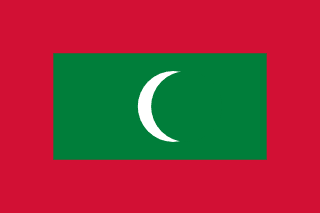Maldives - Geography

Here, let us take a look at the Geography of Maldives. Smallest Asian country; archipelago of 1,190 coral islands grouped into 26 atolls (200 inhabited islands, plus 80 islands with tourist resorts); strategic location along major sea lanes in Indian Ocean. Mother's mean age at first birth is 23.2 years (2016/17 est.) (Note: data represents median age at first birth among women 25-49), whereas, the Maternal mortality ratio is 32 deaths/100,000 live births (2023 est.)
Geographical data of Maldives
| Location | Southern Asia, group of atolls in the Indian Ocean, south-southwest of India |
|---|---|
| Geographic coordinates | 3 15 N, 73 00 E |
| Map references | Asia |
| Tarrain | flat coral atolls, with white sandy beaches; sits atop the submarine volcanic Chagos-Laccadive Ridge |
| Natural Resources | fish |
| Natural Hazards | tsunamis; low elevation of islands makes them sensitive to sea level rise |
| Irrigated Land | 0 sq km (2012) |
| Major rivers (by length in km) | |
| Major aquifers | |
| Land Boundaries | 0 km |
| Border Countries | |
| Coastline | 644 km |
| Climate | tropical; hot, humid; dry, northeast monsoon (November to March); rainy, southwest monsoon (June to August) |
| Area | |
| Total Area | |
| Land Area | 298 sq km |
| Water Area | 0 sq km |
| comparative Area | about 1.7 times the size of Washington, D.C. |
| Maritime Claims | |
| Territorial sea | 12 nm |
| Contiguous zone | 24 nm |
| Exclusive economic zone | 200 nm |
| Elevations | |
| Highest point | 8th tee, golf course, Villingi Island 5 m |
| Lowest point | Indian Ocean 0 m |
| Mean elevation | 2 m |
| Land Use | |
| Agricultural land | 19.8% (2023 est.) |
| Agricultural land: arable land | arable land: 13.4% (2023 est.) |
| Agricultural land: permanent crops | permanent crops: 3% (2023 est.) |
| Agricultural land: permanent pasture | permanent pasture: 3.4% (2023 est.) |
| Forest | 12.5% (2023 est.) |
| Other | 67.7% (2023 est.) |
Population Distribution
About a third of the population lives in the centrally located capital city of Male and almost a tenth in southern Addu City; the remainder of the populace is spread over the 200 or so populated islands of the archipelago
People and Society
In Maldives, the different Ethnic groups are such that we have: Homogeneous mixture of Sinhalese, Dravidian, Arab, Australasian, and African resulting from historical changes in regional hegemony over marine trade routes
| Population | |
|---|---|
| Pop growth rate | -0.2% (2024 est.) |
| Birth rate | 15.1 births/1,000 population (2024 est.) |
| Death rate | 4.3 deaths/1,000 population (2024 est.) |
| Health expenditure | |
| Physicians Density | |
| Hospital bed Density | 5 beds/1,000 population (2020 est.) |
| Total fertility rate | 1.7 children born/woman (2024 est.) |
| Gross reproduction rate | 0.83 (2024 est.) |
| Contraceptive prevalence rate | |
| Est married women (ages 15-49) | 71.9% (2023 est.) |
| Literacy | |
| Education expenditures | |
| Net Migration rate | -12.8 migrant(s)/1,000 population (2024 est.) |
| Nationality | Maldivian | Maldivian(s) |
| Languages | Dhivehi (official, closely related to Sinhala, script derived from Arabic), English (spoken by most government officials) |
| Religions | Sunni Muslim (official) |
| Age Structure | |
| 0-14 years | 22.4% (male 44,321/female 42,626) |
| 15-64 years | 71.5% (male 143,021/female 135,044) |
| 65 years and over | 6.1% (2024 est.) (male 10,397/female 13,449) |
| Dependency Ratios | |
| Total dependency ratio | 39.8 (2024 est.) |
| Youth dependency ratio | 31.3 (2024 est.) |
| Elderly dependency ratio | 8.6 (2024 est.) |
| Potential support ratio | 11.7 (2024 est.) |
| Median Age | |
| Total | 31.9 years (2024 est.) |
| Male | 31.3 years |
| Female | 32.4 years |
| Urbanization | |
| Urban population | 42% of total population (2023) |
| Rate of urbanization | 2.34% annual rate of change (2020-25 est.) |
| Major urban areas (Pop) | 177,000 MALE (capital) (2018). |
| Sex Ratio | |
| At birth | 1.05 male(s)/female |
| 0-14 years | 1.04 male(s)/female |
| 15-64 years | 1.06 male(s)/female |
| 65 years and over | 0.77 male(s)/female |
| Total population | 1.04 male(s)/female (2024 est.) |
| Infant Motality | |
| Total | 24.4 deaths/1,000 live births (2024 est.) |
| Male | 27.3 deaths/1,000 live births |
| Female | 21.3 deaths/1,000 live births |
| Life Expectancy at birth | |
| Total population | 77.4 years (2024 est.) |
| Male | 75.1 years |
| Female | 79.9 years |
| Drinking Water Sources | |
| Improved: urban | urban: 99.1% of population (2022 est.) |
| Improved: rural | rural: 99.9% of population (2022 est.) |
| Improved: total | total: 99.6% of population (2022 est.) |
| Unimproved: urban | urban: 0.9% of population (2022 est.) |
| Unimproved: rural | rural: 0.1% of population (2022 est.) |
| Unimproved: total | total: 0.4% of population (2022 est.) |
| Sanitation facility acess | |
| Improved: urban | urban: 100% of population (2022 est.) |
| Improved: rural | rural: 100% of population (2022 est.) |
| Improved: total | total: 100% of population (2022 est.) |
| Unimproved: urban | urban: 0% of population (2022 est.) |
| Unimproved: rural | rural: 0% of population (2022 est.) |
| Unimproved: total | total: 0% of population (2022 est.) |
| Alcohol consumption per capita | |
| Total | 1.38 liters of pure alcohol (2019 est.) |
| Beer | 0.33 liters of pure alcohol (2019 est.) |
| Wine | 0.59 liters of pure alcohol (2019 est.) |
| Spirits | 0.45 liters of pure alcohol (2019 est.) |
| Other alcohols | 0 liters of pure alcohol (2019 est.) |
| Tobacco use | |
| Total | 28% (2025 est.) |
| Male | 41.5% (2025 est.) |
| Female | 9.2% (2025 est.) |
| Child marriage | |
| Women married by age 15 | 0% (2017) |
| Women married by age 18 | 2.2% (2017) |
| Men married by age 18 | 2.2% (2017) |
Demographic profile
All Important Facts about Maldives
Want to know more about Maldives? Check all different factbooks for Maldives below.









